
Sulmona
Encyclopedia
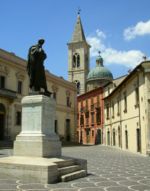

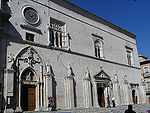
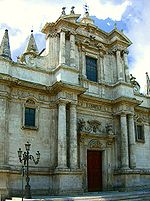
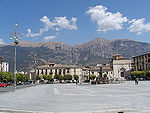
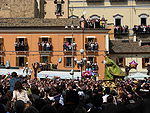
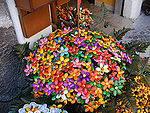
Comune
In Italy, the comune is the basic administrative division, and may be properly approximated in casual speech by the English word township or municipality.-Importance and function:...
of the province of L'Aquila
Province of L'Aquila
thumb|left|200px|Map of the province.The Province of L'Aquila is the largest, most mountainous and least densely populated province of the Abruzzo region of central Italy. It comprises about half the landmass of Abruzzo and occupies the western part of the region...
in the Abruzzo
Abruzzo
Abruzzo is a region in Italy, its western border lying less than due east of Rome. Abruzzo borders the region of Marche to the north, Lazio to the west and south-west, Molise to the south-east, and the Adriatic Sea to the east...
, Italy
Italy
Italy , officially the Italian Republic languages]] under the European Charter for Regional or Minority Languages. In each of these, Italy's official name is as follows:;;;;;;;;), is a unitary parliamentary republic in South-Central Europe. To the north it borders France, Switzerland, Austria and...
, with around 25,000 inhabitants. It is in the Valle Peligna
Valle Peligna
The Valle Peligna, also known as Conca di Sulmona, is a plateau in central Abruzzo, southern Italy, included in the province of L'Aquila. It has a surface of some 100 km²....
, a plateau once occupied by a lake that disappeared in prehistoric times. In the ancient era, it was one of the most important cities of the Paeligni
Paeligni
The Paeligni or Peligni were an Italic people who lived in the Valle Peligna, in what is now Abruzzo, central Italy.-History:The Paeligni are first mentioned as a member of a confederacy which included the Marsi, Marrucini and Vestini, with which the Romans came into conflict in the Second Samnite...
and is known for being the native town of Ovid
Ovid
Publius Ovidius Naso , known as Ovid in the English-speaking world, was a Roman poet who is best known as the author of the three major collections of erotic poetry: Heroides, Amores, and Ars Amatoria...
, of whom there is a bronze statue in the square
Town square
A town square is an open public space commonly found in the heart of a traditional town used for community gatherings. Other names for town square are civic center, city square, urban square, market square, public square, and town green.Most town squares are hardscapes suitable for open markets,...
known as Piazza XX Settembre
Capture of Rome
The Capture of Rome was the final event of the long process of Italian unification known as the Risorgimento, which finally unified the Italian peninsula under King Victor Emmanuel II of the House of Savoy...
located on the town's main road also under his name.
Ancient era
Sulmo was one of the principal cities of the Peligni, as an independent tribe, but no notice of it is found in history before the RomanAncient Rome
Ancient Rome was a thriving civilization that grew on the Italian Peninsula as early as the 8th century BC. Located along the Mediterranean Sea and centered on the city of Rome, it expanded to one of the largest empires in the ancient world....
conquest. A tradition alluded to by Ovid and Silius Italicus
Silius Italicus
Silius Italicus, in full Tiberius Catius Asconius Silius Italicus , was a Roman consul, orator, and Latin epic poet of the 1st century CE,...
, which ascribed its foundation to Solymus
Solymus
In Greek mythology, Solymus was the ancestral hero and eponym of the tribe Solymi in Pisidia, Lycia. He was a son of either Zeus or Ares; his mother's name is variously given as Chaldene, Caldene "daughter of Pisidus", Calchedonia or Chalcea "the nymph".Solymus is known to have been married to his...
, a Phrygia
Phrygia
In antiquity, Phrygia was a kingdom in the west central part of Anatolia, in what is now modern-day Turkey. The Phrygians initially lived in the southern Balkans; according to Herodotus, under the name of Bryges , changing it to Phruges after their final migration to Anatolia, via the...
n and one of the companions of Aeneas
Aeneas
Aeneas , in Greco-Roman mythology, was a Trojan hero, the son of the prince Anchises and the goddess Aphrodite. His father was the second cousin of King Priam of Troy, making Aeneas Priam's second cousin, once removed. The journey of Aeneas from Troy , which led to the founding a hamlet south of...
, is evidently a mere etymological fiction. The first mention of Sulmo occurs in the Second Punic War
Second Punic War
The Second Punic War, also referred to as The Hannibalic War and The War Against Hannibal, lasted from 218 to 201 BC and involved combatants in the western and eastern Mediterranean. This was the second major war between Carthage and the Roman Republic, with the participation of the Berbers on...
, when its territory was ravaged by Hannibal in 211 BCE, but without attacking the city itself. Its name is not noticed during the Social War, in which the Paeligni took so prominent a part; but according to Florus
Florus
Florus, Roman historian, lived in the time of Trajan and Hadrian.He compiled, chiefly from Livy, a brief sketch of the history of Rome from the foundation of the city to the closing of the temple of Janus by Augustus . The work, which is called Epitome de T...
, it suffered severely in the subsequent civil war between Sulla and Gaius Marius
Gaius Marius
Gaius Marius was a Roman general and statesman. He was elected consul an unprecedented seven times during his career. He was also noted for his dramatic reforms of Roman armies, authorizing recruitment of landless citizens, eliminating the manipular military formations, and reorganizing the...
, having been destroyed by the former as a punishment for allegiance to his rival. The writings of that rhetorical writer are not, however, to be taken literally, and it is more probable that Sulmo was confiscated and its lands assigned by Sulla to a body of his soldiers. In all events it is certain that Sulmo was a well-peopled and considerable town in 49 BCE, when it was occupied by Domitius Calvinus
Domitius Calvinus
Gnaeus Domitius Calvinus was a Roman general, senator and consul who was a loyal partisan of Caesar and Octavianus....
with a garrison of seven cohorts; but the citizens, who were favorably inclined towards Julius Caesar
Julius Caesar
Gaius Julius Caesar was a Roman general and statesman and a distinguished writer of Latin prose. He played a critical role in the gradual transformation of the Roman Republic into the Roman Empire....
, opened their gates to his lieutenant M. Antonius as soon as presented himself.
Not much more is known historically of Sulmo, which, however, appears to have continued to be a considerable provincial town. Ovid speaks of it as one of the three municipal towns whose districts composed the territory of the Paeligni: and this is confirmed both by Pliny
Pliny the Elder
Gaius Plinius Secundus , better known as Pliny the Elder, was a Roman author, naturalist, and natural philosopher, as well as naval and army commander of the early Roman Empire, and personal friend of the emperor Vespasian...
and the Liber Coloniarum; yet it does not seem to have ever been large, and Ovid himself designates it as a small provincial town. From the Liber Coloniarum we learn also that it had received the status of a colony, probably in the time of Augustus
Augustus
Augustus ;23 September 63 BC – 19 August AD 14) is considered the first emperor of the Roman Empire, which he ruled alone from 27 BC until his death in 14 AD.The dates of his rule are contemporary dates; Augustus lived under two calendars, the Roman Republican until 45 BC, and the Julian...
; though Pliny does not give it the title of a Colonia. Inscriptions, as well as the geographers and Itineraries, attest its continued existence as a municipal town throughout the Roman Empire
Roman Empire
The Roman Empire was the post-Republican period of the ancient Roman civilization, characterised by an autocratic form of government and large territorial holdings in Europe and around the Mediterranean....
.
The chief claim to fame of Sulmo is derived from its having been the birthplace of Ovid, who repeatedly alludes to it as such, and celebrates its salubrity, and the numerous permanent streams of clear water in which its neighbourhood abounded. But, like the whole district of the Paeligni, it was extremely cold in winter, whence Ovid himself, and Silius Italicus in imitation of him, calls it "gelidus Sulmo" Its territory was fertile, cultivation of both in grain and wine are common, and one district, the Pagus Fabianus, is particularly mentioned by Pliny for the care bestowed on the irrigation of the vineyards.
Middle Ages and Renaissance
Traditionally, the beginning of the Christian ageChristianity
Christianity is a monotheistic religion based on the life and teachings of Jesus as presented in canonical gospels and other New Testament writings...
in Sulmona is set in the 3rd century AD. The city was part of the diocese of Valva, while a Sulmonese bishop is known from the 5th century. One of the earliest Bishops was St. Pamphilus (San Panfilo), an Italian pagan convert to Christianity in the 7th Century from nearby Corfinium
Corfinium
Corfinium was a city in Ancient Italy, on the eastern side of the Apennines, due east of Rome. It is now near the modern Corfinio, in the province of L'Aquila .-History:...
. He was elected bishop of Valva in 682 AD and died in 706 AD. He is the patron saint
Patron saint
A patron saint is a saint who is regarded as the intercessor and advocate in heaven of a nation, place, craft, activity, class, clan, family, or person...
of Sulmona and is buried in his namesake church, the present cathedral of Sulmona.
Sulmona became a free commune under the Normans. Under Emperor Frederick II
Frederick II, Holy Roman Emperor
Frederick II , was one of the most powerful Holy Roman Emperors of the Middle Ages and head of the House of Hohenstaufen. His political and cultural ambitions, based in Sicily and stretching through Italy to Germany, and even to Jerusalem, were enormous...
an aqueduct was built in the town, one of the most important construction of the era in the Abruzzo; the emperor made it the capital of a large province, as well the seat of a tribunal and of a fair, which it however lost with the arrival of the Angevines
Capetian House of Anjou
The Capetian House of Anjou, also known as the House of Anjou-Sicily and House of Anjou-Naples, was a royal house and cadet branch of the direct House of Capet. Founded by Charles I of Sicily, a son of Louis VIII of France, the Capetian king first ruled the Kingdom of Sicily during the 13th century...
. Despite that, it continued to expand and a new line of walls was added in the 14th century.
In the 16th century a flourishing paper industry was started.
Modern age
In 1706 the city was nearly razed by an earthquake. While, much of the medieval city was destroyed by the earthquake, some remarkable buildings survive such as the Church of Santa Maria della Tomba, the Palazzo Annunziata, the Aqueduct and the Gothic portal on Corso Ovidio.Much of the city was then rebuilt in the prevailing elegant Baroque style of the 18th Century.
Sulmona experienced an economic boom in the late 19th Century due its railway hub and strategic geographic position between Rome and the Adriatic coast.
The anarchist and labor organiser Carlo Tresca
Carlo Tresca
Carlo Tresca was an Italian-born American newspaper editor, orator, and labor organizer who was a leader of the Industrial Workers of the World during the decade of the 1910s. Tresca is remembered as a leading public opponent of fascism, stalinism, and Mafia infiltration of the trade union movement...
was born there in 1879 and was active in the Italian Railroad Workers' Federation until emigrating to the US in 1904, to escape a prison term.
Sulmona's strategic position also made it a target for air raids during World War II
World War II
World War II, or the Second World War , was a global conflict lasting from 1939 to 1945, involving most of the world's nations—including all of the great powers—eventually forming two opposing military alliances: the Allies and the Axis...
. The railway station, the industrial sections and parts of the old town were damaged, but today they have been mostly restored.
Campo 78
Campo 78 at Sulmona served as a POW camp in both world wars. During World War IWorld War I
World War I , which was predominantly called the World War or the Great War from its occurrence until 1939, and the First World War or World War I thereafter, was a major war centred in Europe that began on 28 July 1914 and lasted until 11 November 1918...
, it housed Austrian prisoners captured in the Isonzo
Battles of the Isonzo
The Battles of the Isonzo were a series of 12 battles between the Austro-Hungarian and Italian armies in World War I. They were fought along the Soča River on the eastern sector of the Italian Front between June 1915 and November 1917...
and Trentino campaigns; during World War II, it was home to as many as 3,000 British and Commonwealth officers and other ranks captured in North Africa.
The camp itself was built on a hillside and consisted of a number of brick barracks surrounded by a high wall. During World War II, conditions in Sulmona, as in many Italian camps, were good, especially in the two officers’ compounds. Regular rations of macaroni soup and bread were augmented by fresh fruit and cheese in the summer, and food parcels from the International Committee of the Red Cross
International Committee of the Red Cross
The International Committee of the Red Cross is a private humanitarian institution based in Geneva, Switzerland. States parties to the four Geneva Conventions of 1949 and their Additional Protocols of 1977 and 2005, have given the ICRC a mandate to protect the victims of international and...
were distributed regularly. For recreation, the prisoners laid out a football field, and they also had equipment for cricket and basketball. There was a theater, a small lending library, at least one band, and a newspaper produced by a group of prisoners.
In September 1943, as the Italian government neared collapse, the inmates of Sulmona heard rumors that the evacuation of the camp was imminent. They awoke one morning to discover that their guards had deserted them. On 14 September, German troops arrived to escort the prisoners northwards, to captivity in Germany, but not before hundreds of them had escaped into the hills. One such escapee was the South African author, Uys Krige
Uys Krige
Mattheus Uys Krige was a South African writer of novels, short stories, poems and plays in both Afrikaans and English. He was born in Bontebokskloof in the Cape Province and educated at the University of Stellenbosch.From 1931 to 1935 he lived in France and Spain, acquiring fluency in both...
, who described his experience in a book titled The way out.
There were two other smaller camps nearby Fontana d'Amore which held British Officers and Villa Orsini which held very senior Allied officers captured during World War Two, including Air Marshal Owen Tudor Boyd
Owen Tudor Boyd
Air Marshal Owen Tudor Boyd CB, OBE, MC, AFC was an officer in the British Royal Flying Corps during most of World War I...
(1889–1944), Major-General Sir Adrian Carton de Wiart
Adrian Carton de Wiart
Lieutenant-General Sir Adrian Carton de Wiart VC, KBE, CB, CMG, DSO , was a British officer of Belgian and Irish descent...
(1880–1963), Brigadier James Hargest
James Hargest
Brigadier James Hargest CBE, DSO & 2 bars, MC, ED, MP, was a New Zealand military officer and politician.Hargest was born in Gore, where his father was a farmer. He joined the Territorial Force in 1911, and when World War I broke out, he volunteered to serve in the New Zealand Expeditionary Force,...
(1891–1944), Lieutenant General Sir Philip Neame
Philip Neame
Lieutenant General Sir Philip Neame VC, KBE, CB, DSO, KStJ was a British Army officer and recipient of the Victoria Cross, the highest and most prestigious award for gallantry in the face of the enemy that can be awarded to British and Commonwealth forces...
(1888–1978), General Sir Richard Nugent O'Connor (1889–1981). All were subsequently transferred to Castello di Vincigliata
Vincigliata
Vincigliata Castle is a medieval castle which stands on a rocky hill to the east of Fiesole in the Italian region of Tuscany. In the mid-nineteenth century the building, which had fallen into a ruinous state, was acquired by the Englishman John Temple-Leader and entirely reconstructed in the...
Campo PG12 near Florence.
Main sights
Sulmona has various piazzas, churches and palaces of historical and touristic interest. Some of these include:- The city's cathedral, sitting on the northwest side of the old city and was built on the site of a Roman temple. It contains a crypt which retains its Romanesque appearance despite the 18th century renovation of the main church.
- Piazza XX Settembre. One of the main squares of the city, including a bronze statue of the Roman poet OvidOvidPublius Ovidius Naso , known as Ovid in the English-speaking world, was a Roman poet who is best known as the author of the three major collections of erotic poetry: Heroides, Amores, and Ars Amatoria...
. - Corso Ovidio. The city's main thoroughfare connects the cathedral and the major piazzas and is lined by elegant covered arcades, shops, cafes, palaces and churches.
- Palazzo Annunziata and Chiesa della SS. Annunziata. The Palace, one of the rare examples of late medieval/early RenaissanceRenaissanceThe Renaissance was a cultural movement that spanned roughly the 14th to the 17th century, beginning in Italy in the Late Middle Ages and later spreading to the rest of Europe. The term is also used more loosely to refer to the historical era, but since the changes of the Renaissance were not...
architecture in Sulmona that survived the earthquake of 1706. Its facade contains fine sculpture and tracery work. Inside the Palazzo is a museum showing the Roman history of the city as well as various artifacts. The church is a fine example of Baroque architecture and has a beautiful interior and bell tower. - Piazza Garibaldi is the largest square in town with a large baroque era fountain. A Palio style medieval festival and horse race known as the Giostra Cavalleresca takes place here every year in the Summer. At Easter, crowds gather to witness the Madonna che Scappa. This ceremony involves the procession of a statue of the Madonna which is carried across the square while the bearers run to encounter a statue of the resurrected Christ on the other side of the square. On the south side of the Piazza is the 12th Century Gothic aqueduct. The square hosts a market twice a week on Wednesdays and Saturdays.
The remains of the ancient city are of little interest as ruins, but indicate the existence of a considerable town; among them are the vestiges of an amphitheatre
Amphitheatre
An amphitheatre is an open-air venue used for entertainment and performances.There are two similar, but distinct, types of structure for which the word "amphitheatre" is used: Ancient Roman amphitheatres were large central performance spaces surrounded by ascending seating, and were commonly used...
, a theatre, and thermae, all of them located outside the gates of the modern city. About 3 km from the city, at the foot of Monte Morrone, are some ruins of reticulated masonry, traditionally believed to be Ovid's villa. Today, they are more properly identified as the sanctuary of Hercules Curinus. Nearby is the Badia Morronese, a large (c. 119x140 m) religious complex located near Pope Celestine V
Pope Celestine V
Pope Saint Celestine V, born Pietro Angelerio , also known as Pietro da Morrone was elected pope in the year 1294, by the papal election of 1292–1294, the last non-conclave in the history of the Roman Catholic Church...
's hermitage. It was founded by Celestine as a chapel in 1241, and was enlarged and later made into a convent.
Confetti
Sulmona is the home of the Italian confectionery known as confettiJordan Almonds
Jordan almonds, also known as sugared almonds or confetti, are a type of confectionery consisting of almonds covered with a candy coating in various colors, originating from Italy and particularly typical of the town of Sulmona...
. These are sugar coated almonds and are traditionally given to friends and relatives on weddings and other special occasions. Confetti can be eaten or simply used as decoration. The local artisans also color these candies and craft them into flowers and other creations. There are two main factories in town and several shops that sell these items.
Twin towns
HamiltonHamilton, Ontario
Hamilton is a port city in the Canadian province of Ontario. Conceived by George Hamilton when he purchased the Durand farm shortly after the War of 1812, Hamilton has become the centre of a densely populated and industrialized region at the west end of Lake Ontario known as the Golden Horseshoe...
, Canada
Canada
Canada is a North American country consisting of ten provinces and three territories. Located in the northern part of the continent, it extends from the Atlantic Ocean in the east to the Pacific Ocean in the west, and northward into the Arctic Ocean...
Constanţa
Constanta
Constanța is the oldest extant city in Romania, founded around 600 BC. The city is located in the Dobruja region of Romania, on the Black Sea coast. It is the capital of Constanța County and the largest city in the region....
, Romania
Romania
Romania is a country located at the crossroads of Central and Southeastern Europe, on the Lower Danube, within and outside the Carpathian arch, bordering on the Black Sea...
Burghausen
Burghausen, Altötting
Burghausen is the largest city in the Altötting district of Oberbayern in Germany. It is situated on the Salzach river, near the border with Austria. Its castle, atop a ridge, is the longest castle in Europe .- History :...
, Germany
Germany
Germany , officially the Federal Republic of Germany , is a federal parliamentary republic in Europe. The country consists of 16 states while the capital and largest city is Berlin. Germany covers an area of 357,021 km2 and has a largely temperate seasonal climate...
Sources
Relating to Sulmona POW camp, Villa Orsini and Fontana d'Amore:- Playing with Strife', The Autobiography of a Soldier, Lt-Gen. Sir Philip Neame, V.C., K.B.E., C.B., D.S.O., George G Harrap & Co. Ltd, 1947, 353 pages,
- 'Farewell Campo 12', Brigadier James Hargest, C.B.E., D.S.O. M.C., Michael Joseph Ltd, 1945, 184 pages contains a sketch map of route of capture and escape 'Sidi Azir - London (inside front cover),(no index)
- 'Happy Odyssey', Lt-Gen. Sir Carton De Wiart,V.C.,K.B.E.,C.M.G.,D.S.O., Jonathan Cape Ltd, 1950, in PAN paperback 1956, re-printed by Pen & Sword Books 2007, 287 pages, ISBN 184415539-0 (Foreword by Winston S Churchill)
- 'Always To-Morrow', 1951, John F Leeming, George G Harrap & Co. Ltd, London, 188p, Illustrated with photographs and maps, (Tells of the authors' experiences as a prisoner of the Italians during WW2)
- 'To War with Whitaker', 1994, The wartime diaries of The Countess of Ranfurly 1939 -1945, William Heinemann Ltd, London, 375 pages, ISBN 0-434-00224-0
- 'The way out (Italian intermezzo)', Uys Krige, (South African author), 1946, Collins, London, (also Maskew Miller, Cape Town 1955 revised edition)
External links
- Official website
- Sulmona.org, Guide to Ovidio's town
- Inside Abruzzo
- Medioeval Giostra Cavalleresca of Sulmona
- Sulmona - Pictures of Sulmona

